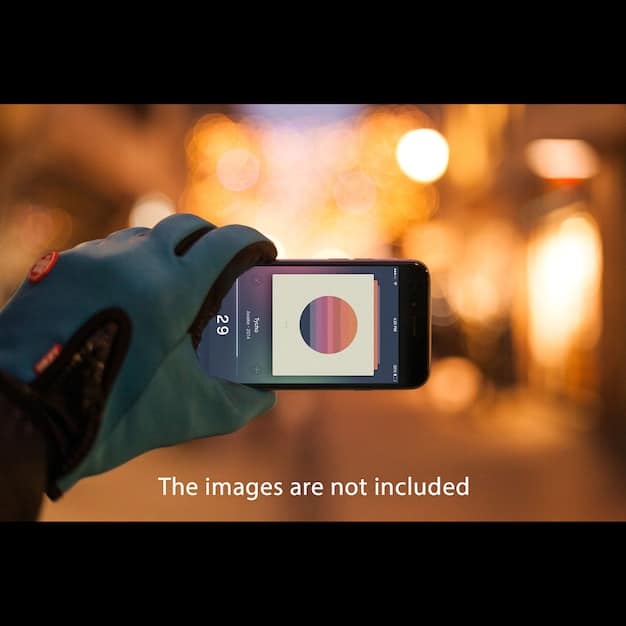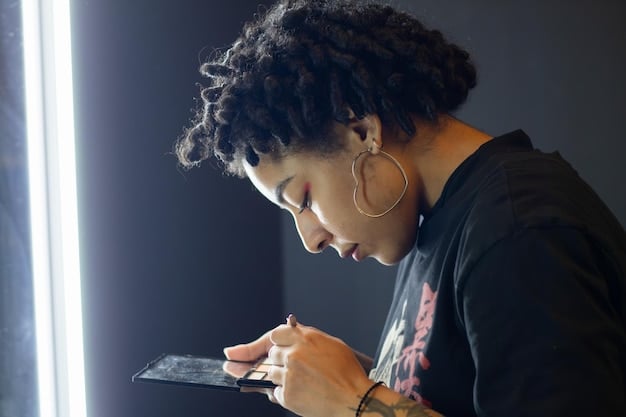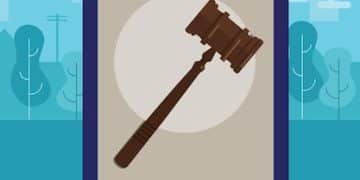TikTok Legal Considerations: Copyright Laws and Avoid Infringement

Navigating TikTok’s legal landscape requires understanding copyright laws to avoid infringement claims; this article explores key considerations for content creators to ensure compliance and protect their work.
Creating content on TikTok opens doors to viral fame, but it also comes with legal responsibilities. This article dives into TikTok Legal Considerations: Understand Copyright Laws and Avoid Infringement Claims, helping you navigate the platform’s rules and regulations.
Understanding Copyright Law Basics for TikTok
Copyright law is at the heart of content creation on TikTok. Knowing the basics is crucial to avoid legal issues. This section will outline these fundamentals, focusing on how they apply to your TikTok activity and protect you from possible legal action.
What is Copyright?
Copyright is a legal right granted to the creators of original works of authorship, including literary, dramatic, musical, and certain other intellectual works. This right gives creators exclusive control over how their work is used.
Copyright Protection on TikTok
On TikTok, copyright protects various elements such as music, videos, and original audio. If you use copyrighted material without permission, you risk facing infringement claims, leading to takedown requests or legal action. Therefore, it’s important to always respect the rights of original creators.
- Ensure you have the rights to use any music you incorporate into your videos.
- Avoid using clips from movies or TV shows without proper licensing.
- Create original content or seek permission before using someone else’s work.
Understanding these basic principles helps safeguard your TikTok account and ensures legal and moral behavior.

Fair Use and Copyright Exceptions on TikTok
Even with copyright laws in place, there are exceptions known as “fair use” that allows certain uses of copyrighted material without permission. Understanding these exceptions can provide options, but it’s crucial to know the boundaries properly. The following section explains the boundaries of fair use.
Defining Fair Use
Fair use allows limited use of copyrighted material without needing permission from the copyright holder. This could include commentary, criticism, parody, or educational purposes. Factors such as the purpose, nature, amount, and effect on the market value of the copyrighted work are considered.
Applying Fair Use to TikTok Content
When using copyrighted material on TikTok, consider how your use qualifies as fair use. Are you adding commentary, criticism, or creating a parody? The more transformative your use, the more likely it falls under fair use. Document how this aligns with the key conditions to support your fair use claim.
- Ensure your use is transformative, adding new expression or meaning.
- Limit the amount of copyrighted material you use only take what you need.
- Consider the impact market – a parody doesn’t deprive from the potential customers of the artist.
Use fair use responsibly to respect copyright law and cultivate original content and artistic expression.
Navigating TikTok’s Music Library and Licensing
Music is a crucial element in most TikTok videos. Using TikTok’s music library and understanding licensing can help you stay within legal boundaries. Here’s what you need to be aware of when choosing music for your TikTok content.
TikTok’s Music Library
TikTok offers a vast music library with pre-cleared tracks that users can incorporate into their videos. This option simplifies the process of using music legally, as TikTok already handles the licensing agreements.
Understanding Music Licensing
If you wish to use music outside of TikTok’s library, you’ll need to obtain the necessary licenses. This includes both a synchronization license (for using the music in a video) and a master use license (for using the specific recording). Obtaining these licenses can be complex and costly, so plan accordingly.

- Explore TikTok’s music library as a primary option for including music in your videos.
- If using external music, research and obtain synchronization and master use licenses.
- Keep records of licensing agreements and permissions for future reference.
By making informed music selection while understanding the basics of music licensing, you can enrich your TikTok content without legal problems.
Creating Original Content and Avoiding Plagiarism
Creating original content is fundamental to building a successful and legally sound presence on TikTok. Originality not only enhances your brand but also keeps you out of legal disputes. The following section underscores the importance of originality in your TikTok experience.
The Value of Originality
Creating your own unique content can set you apart on TikTok. Original videos, sounds, and ideas attract viewers and increase your engagement and credibility.
How to Avoid Plagiarism
Always create your own work. If you are inspired by an already existing piece it’s fine, but you shouldn’t copy it. When using external sources for inspiration, make sure you adapt and incorporate them correctly and legally.
Creating your own TikTok content leads to originality and prevents copyright infringement. When you build your reputation and grow your audience, you’re building a strong brand while remaining legally compliant.
Dealing with Copyright Infringement Claims
Even with cautious planning, you may face the rare situation of a copyright infringement claim on TikTok. Knowing how to handle these claims is important to protect your account. This section provides practical steps you can take if you receive an infringement notice.
Responding to a Takedown Notice
If you receive a takedown notice from TikTok related to copyright infringement, take it seriously. Evaluate the claim carefully, review the content in question, and determine if the claim is valid. If you believe the claim is incorrect or unsubstantiated, you have the option to file a counter-notice.
Filing a Counter-Notice
A counter-notice tells TikTok that you believe the takedown request was issued in error. You must provide information as to why you have the right to use the work. Ensure your counter-notice is honest and accurate, as false statements can carry legal consequences.
- Assess the validity of the takedown notice by comparing to the possible claims against you.
- If you believe the notice has been sent with errors, prepare a precise and factual counter-notice.
- Seek legal guidance to ensure your response is appropriate and in compliance with the law.
Handling copyright infringement claims with diligence and accuracy can help you safeguard your TikTok profile and protect your rights.
TikTok Policies and Community Guidelines
In addition to copyright laws, TikTok has its own specific policies and community guidelines that govern content creation on the platform. Familiarizing yourself with these standards will help you avoid violations and ensure compliance. This section focuses on these community standards.
Understanding TikTok’s Rules
TikTok’s community guidelines outline what types of content are allowed on the platform. These policies address many areas, including copyright, hate speech, bullying, and illegal activities. Violations can lead to removal of content or suspension of accounts.
How Policies Relate to Copyright
TikTok’s policies reinforce copyright laws by prohibiting users from posting content that infringes on others’ intellectual property rights. TikTok takes swift action against copyright infringements, which emphasizes their respect for intellectual property.
Complying with TikTok’s guidelines and policies not only helps you avoid legal issues but also contributes to a safer and more respectful online community.
| Key Point | Brief Description |
|---|---|
| 🎵 Music Use | Always use TikTok’s library or get proper licenses. |
| 💡 Original Content | Create unique content to set your brand apart. |
| 🛡️ Fair Use | Use copyrighted material reasonably for commentary, or parody. |
| 🚫 Claims | Respond carefully to takedown notices. |
Frequently Asked Questions (FAQs)
Copyright protects original works, like music and videos. On TikTok, ensure you have rights to use content to avoid takedown requests or legal issues.
Using music from other platforms without permission can lead to copyright infringement. Stick to TikTok’s music library or obtain proper licenses.
Evaluate the notice carefully and if you believe it’s an error you can file a counter-notice after determining it to be an error.
Fair use allows some use of copyrighted material for purposes like commentary or parody. Ensure your use is transformative and does not harm the work’s value.
TikTok’s community guidelines define acceptable content on the platform. Following them helps avoid violations and contributes to a healthier community.
Conclusion
Understanding and respecting copyright considerations is crucial for success on TikTok while staying compliant and fostering creativity. By following the guidelines outlined here, you can navigate the legal landscape of TikTok and protect both your content and the rights of others.






